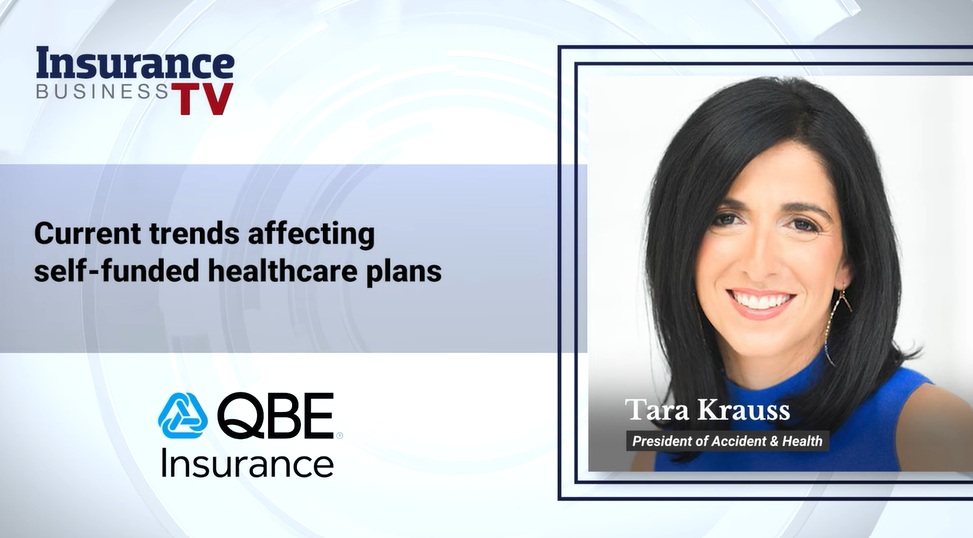[00:00:00] Paul Lucas: Hello everyone and welcome to the latest edition of Insurance Business TV as we delve into the A&H market with QBE North America. Now the company has released its 2025 Accident and Health Market Report which offers insights on current trends affecting self-funded healthcare plans. Key topics include medical stop-loss claims trends, growth in the specialty pharmacy market, and factors hindering a healthier society. Well, to discuss its findings and more, we welcome Tara Krauss, President of Accident and Health at QBE North America. Tara, welcome to IBTV.
[00:00:30] Tara Krauss: Oh, thanks for having me today.
[00:00:32] Paul Lucas: So to kick things off, Tara, let’s talk about medical stop-loss coverage. What makes it an important part of a self-funded employer’s benefits strategy?
[00:00:39] Tara Krauss: Thanks, Paul. I think that’s a really important question and one that sometimes gets overlooked in a self-funded plan. So self-insured plans really dominate the commercial market today. Over 65% of health plans are self-insured and actually upwards of 85% of mid to large employer groups. That’s 500 plus self-insured. It’s definitely the preferred option for employers seeking to control costs and have the ability to customize their plans. Stop loss is pretty common for a self-insured plan for a number of reasons, growing increasingly important with today’s current claims trends. Nearly all small to mid-market self-insured plans will have stop loss, but it’s becoming even more prevalent with the large group market. We’re seeing an increase in both frequency and severity of claims in recent years, making stop loss coverage really a wise choice to protect the plan assets. In fact, our claims trend study that we’ll probably get into a little bit today revealed that our million dollar claims have doubled in the last four years time. So it’s a really a great asset, a safety net for the self-insured plan. Current trends affecting self-funded healthcare plans.mp4
[00:01:46] Paul Lucas: Well, you brought me nearly to it there. Let’s talk a little bit about some of those key findings from this year’s report. What should brokers and employers be paying attention to?
[00:01:54] Tara Krauss: Good question. I think it’s important that they continue to explore cost-effective point solution options, plan enhancements to mitigate those current claims trends that we’ll talk about today. The importance of increasing prevalence of disease is something that we’ve been focusing a ton on. The proliferation of these $1 million claims post the ACA, specialty pharmaceuticals, and the number of new approvals each year that drive those chronic disease and some of those rare conditions that are out in the market now. Employers really need to educate themselves. And that’s where we can rely on our brokers to focus and educate the consumer.
[00:02:28] Paul Lucas: And of course, the report highlights rising claims costs tied to cancer, circulatory disease and premature births as well. So what’s driving those trends and what are the implications for benefit strategies and stop-loss coverage?
[00:02:40] Tara Krauss: There’s a number of things driving the trends, but I’d say for this question, I’d focus on cancer, circulatory, and some of those premature birth claims. And I can get into that a little bit. Cancer continues to be that kind of the elephant in the room year over year in the healthcare space. It’s the predominant driver of stop-loss claims on our book of business and many of my competitors. It drives nearly a third to a fourth of our full book of excess loss claims, regardless of spec deductible. Outside of root cause, the cost of these claims is largely driven by the treatment. These are really targeted and expensive treatments, not like what we had seen 20 to 30 years ago, where you had one diagnosis and one treatment plan. There are a multitude of treatment plans depending on the type of tumor, the staging of the tumor, the age of the individual, and what comorbidities they might have. Some of these targeted and expensive therapies include CAR T-cells, immunotherapy. Stem cell transplants that used to be maybe third or fourth line of defense are now moving up to a first or second line of defense in the treatment plan. These are cancers that might be getting treated more aggressively at earlier stages because of the advanced staging of an initial diagnosis. Certainly, we looked at and have continued to look at the impact of deferred care as a result of the pandemic. A lot of people stayed home. They weren’t getting a preventative care cancer. Had the opportunity to progress to a further stage, ultimately getting more costly treatments. Our book frequency, for example, we see about 21 neoplasm cancer-related claims for every 10,000 employees on a health plan. And the average of those claims is upwards of 375,000, roughly 365, to be exact. Circulatory claims is another big one. And something we did focus on a lot this year in our review. This is anything related to heart failure, AFib, valve disorders, pulmonary disease. These claims are largely driven by chronic disease, comorbidities, things like diabetes, obesity, hypertension. Healthcare-related costs to these conditions is expected to triple in the next 30 years. So there has to be a ton of focus in the healthcare space on these conditions. The frequency in our claims has risen about 60% post-COVID, you know, sedentary lifestyles. The American lifestyle has certainly contributed. And last, you had mentioned premature births. So we haven’t really seen an… increased incidence of premature births but we’ve really observed an increase in pre-term births that have congenital anomalies that increases the severity of the claim because there is earlier and more aggressive interventions with that type of premature birth. Current trends affecting self-funded healthcare plans.mp4 Current trends affecting self-funded healthcare plans.mp4
[00:05:24] Paul Lucas: Okay and the report also talks about the impact of poor societal health as well so can you share some more insights on that topic and how it might be impacting claims?
[00:05:32] Tara Krauss: Sure Paul. So reinsurers don’t tend to take too much look at what’s driving these claims, right? We’re reimbursing them. And we felt it was important to take a look at, really, what is driving it from a societal perspective, especially with the focus of the current administration. So the market is definitely seeing an increasing cancer diagnosis across the board, but specifically breast, colon, pancreas, lung, and younger age, more aggressive stage. A higher diagnosis rate in women, specifically younger women under 50, related to breast and thyroid. This is really less about genetics and more about environmental and lifestyle factors. Certainly better detections at play, genetic factors, and your life factor into your lifetime risk of cancer. But the trends are really pointing at environmental and lifestyle as being the driving factors of what’s causing these alarming trends. 90 to 95% of cancers are caused by what we consider like a modifiable factor that includes everything from tobacco use, alcohol intake, living a sedentary lifestyle, diet and obesity, with over 50% of our diet in the U.S. being processed and 85% of what’s on the shelves having some questionable ingredients that could be contributing to chronic disease, inflammation in the body, our food supply, infectious agents, and certainly even the healthiest of crops being sprayed with pesticides that have some alarming chemicals that are getting attention currently in the US. One study I read suggests that the incidence of early onset cancer is expected to increase 50% globally in the coming years. So it is something that we as a society and those in the healthcare space should really be calling attention to and focusing on. Current trends affecting self-funded healthcare plans.mp4 Current trends affecting self-funded healthcare plans.mp4
[00:07:12] Paul Lucas: QBE, of course, recently expanded its offerings to Taft-Hartley and multi-employer health plans. So what makes this market unique and how is QBE addressing the needs?
[00:07:22] Tara Krauss: Sure. We’re really excited to be in this space and have this new offering. We’ve got a great team. The labor unions are really uniquely positioned to handle the management of claims. Due to both those relationships, they’re a very relationship-driven cohort and they have strong alignment with their key constituents, those that are leveraging the plan. 95% of members on a union plan have access to health care as opposed to 65% in the general commercial market. And those individuals are seven times more likely to seek regular health care visits with their primary care. Obviously, seeking health care visits, you get the screening and the prevention and likely to get earlier detection on anything you have going on or direction on what you might need to mitigate to prevent lifetime risks. Unions tend to also implement, from a plan control basis, better utilization management. They implement things like reference based pricing and centers of excellence to manage their costs. They’re really well managed plans. They have strong governance. Speaking from a stop loss insurance partner, we see higher close ratios on the business we quote, lower claims and an incredibly loyal customer base. So once you have a union customer, they tend to stick with you over the long term. Current trends affecting self-funded healthcare plans.mp4
[00:08:34] Paul Lucas: And given what the report highlights, what advice would you give to brokers when it comes to helping clients plan for the next year?
[00:08:40] Tara Krauss: From a stop loss perspective, I’d ask that they just continue to share their knowledge with the broader customer base on educating them on the lifestyle factors stuff that we talked about, because we tend to kind of sit back. And I think that’s something we all need to start leaning into and to really impact change. A solid PBM management plan. It all starts with that, have a judicious focus on a transparent vendor in that space. There’s a real lack of transparency with some of the big players. So focusing on reducing waste, how are rebates handled? Side of care controls are in place. As far as the reinsurance renewals, educating the employer groups on what leverage trend is and how important it is, even slight modifications, increases to the employers, what we call their specific deductible year over year helps to mitigate their renewal increases. Partnering certainly with a financially sound carrier that shows up at time of claim, really, it only takes one bad claim experience to lose a long-term client. So credibility, A-rated, responsive and service-led team, I think is critically important. Current trends affecting self-funded healthcare plans.mp4
[00:09:44] Paul Lucas: Yeah, great advice. And obviously a lot to gauge from the report as well. If anyone wants to know more, Tara, where can they find it?
[00:09:51] Tara Krauss: Sure. They can go to the QBE website, qbe.com and search for the A&H page. And we’ve got a copy of the report there.
[00:09:58] Paul Lucas: Excellent. And once you’ve finished there, make sure you come back to us too. We’ll be waiting to see you next time right here on Insurance Business TV. Current trends affecting self-funded healthcare plans.mp4




